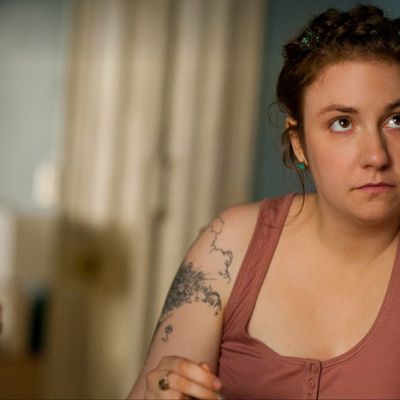
As it does from time to time, most recently with James Fenton’s loving takedown of Downton Abbey, the New York Review of Books has once again dipped into the world of television for a highbrow take on a (relatively) highbrow series. The show in question is Girls, and Elaine Blair does not waste time: “There are many reasons to love Lena Dunham’s HBO television show Girls,” reads the opening sentence, “and some of them have nothing to do with sex, but I’m going to begin with the sex scene in the second episode that most critics have mentioned and described with some amount of repugnance or lament.” So begins the official Backlash to the Backlash, and also a thoughtful essay on the sex — and the critical concern about the sex — portrayed on Girls. Please, join us for a quick breakdown, won’t you?
1. The “bad” sex scenes are good, honest television.
In other words, with her humane and humorous depictions of both characters, Dunham has set the viewer free from having to keep score on either the man’s or the woman’s behalf. We can admire the two actors’ chemistry together. We can feel the erotic charge of the scene in spite of its limitations, qua sex, for Hannah. We can contemplate Hannah’s lack of sexual confidence without condemning Adam. We can appreciate, rather than lament, Hannah’s attraction to Adam despite the fact that he is wont to do things like dismiss her from his apartment with a brusque nod while she is still chatting and gathering her clothes and purse. We can just generally marvel at the complexity with which Girls treats a relationship like Hannah and Adam’s.
2. Girls’ graphic, porn-tinged sex scenes are actually “liberating.”
Hollywood sex scenes are not typically interested in even hinting at the ways that people actually reach orgasm, and this is disheartening above all for female viewers, who develop a certain melancholy by the time that they have seen their one thousandth sex scene in which it is taken for granted that by sex we mean mutually rapturous face-to-face vaginal intercourse. Even though the only person having fun in Dunham’s scene is the guy, there is nonetheless a certain joy in seeing someone get off in some other way…If Adam is meant to be obviously under the influence of porn, and his moves echo a staple porn sequence, what Dunham has done with the scene suggests that pornographic convention can actually be an antidote to a certain kind of prudish Hollywood bias.
3. Sex is not the endgame; it’s a means of artistic or personal discovery.
For all of its emphasis on sexual and romantic experience, Girls never suggests that a smoothly pleasant sex life is something worthy of serious aspiration. The ultimate prize to be wrung from all of these baffling sexual predicaments is a deeper understanding of oneself. We never quite forget that Hannah is a writer, specifically a writer of personal essays, a form dedicated to investigating the humiliating, perverse, and self-defeating aspects of one’s own nature.
4. Girls is better than Sex and the City.
With this scene Girls swiftly dispenses with its debt to Sex and the City, and also demonstrates how much finer its own sensibilities are. Sex and the City trades in coarse satirical categories; everything that happens to the main characters turns out to be an example of some contemporary social or sexual phenomenon, every man or woman they meet is caught, chloroformed, pinned, and labeled as a particular urban type. Girls, on the other hand, shows a young woman deep under the influence of coarse categories.
And a bonus thought on the “doormat” alter egos that Lena Dunham creates for herself:
It is sometimes uncomfortable to watch Aura [from Tiny Furniture] pursue the men with puppyish hopefulness and thoroughly fail to stand up for herself no matter how loutish their behavior. At the same time, it is also a relief, for Dunham has overthrown the tyranny of pluck. Her alter ego might be maddeningly unconfident, submissive, and eager to please in some situations, but she is not pathetic: she holds her place at the center of the film, an object of our interest and identification despite a long list of unflattering qualities, and she is not reformed at the end of the movie.
There is almost no mention of the racial debate surrounding the show, but as Blair states pretty plainly, the essay is only concerned with sex. So, bad sex is good again! And Hannah is not a pushover. How are we feeling about this?




